 Sony Ericsson have announced their new M600 handset, a tri-band (900/1800/1900 plus UMTS 2100 for 3G data outside the US) jobbie, with Symbian OS 9.1 and UIQ 3.0 operating systems.
Sony Ericsson have announced their new M600 handset, a tri-band (900/1800/1900 plus UMTS 2100 for 3G data outside the US) jobbie, with Symbian OS 9.1 and UIQ 3.0 operating systems.
Measuring a pocket unruffling 15 mm thick, the 3G-capable communicator sports a Blackberry 7100x style dual function QWERTY keyboard and a large, touch-sensitive, 2.6-inch 240×320 262K colour display.
The dual function thumb-board offers continuous spell checking and word completion, with input aided by a 3-way jog dial and handwriting recognition.
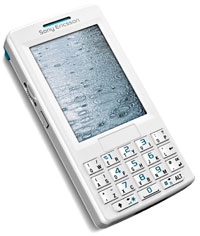 Touted as a “fully-specified email tool and mobile phone”, the handset offers true multitasking, so a user can, for example, browse the Internet while chatting away on the phone.
Touted as a “fully-specified email tool and mobile phone”, the handset offers true multitasking, so a user can, for example, browse the Internet while chatting away on the phone.
The onboard push email applications and remote synchronisation options should please the swivel-action office crowd, with support for AlteXia, Ericsson Mobile Office (EMO), iAnywhere OneBridge, Intellisync, Microsoft Exchange ActiveSync, RIM – BlackBerry Connect , Seven, Visto and standard email.
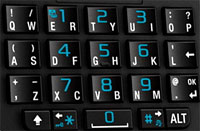 For road warriors and shuffling suits, there’s the facility to read and edit PowerPoint, Word and Excel documents and Adobe PDF files on the move, with the popular Opera 8 browser provided for surfing the Internet.
For road warriors and shuffling suits, there’s the facility to read and edit PowerPoint, Word and Excel documents and Adobe PDF files on the move, with the popular Opera 8 browser provided for surfing the Internet.
For storing email attachments and multimedia content, there’s 80MB of internal memory, with Sony bundling in an additional 64MB Memory Stick in their new, teensy-weensy, bound-to-lose-it-in-seconds Micro M2 card format.
The built in media player offers support for MP3, AAC, ACC+, E-AAC+ and m4a, streaming audio and video playback 30 fps with Stereo Bluetooth support.
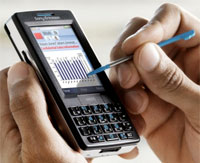 In line with its business focus, there’s no built in camera, and Wi-Fi is an unfortunate omission too.
In line with its business focus, there’s no built in camera, and Wi-Fi is an unfortunate omission too.
For some reason we kept thinking of a Spectrum ZX-80 when we looked at the phone, but I guess that’s no bad thing.
Sony Ericsson will be making the new phone available in Granite Black and Crystal White from Q2 2006.
 They’ve been bustier than Jock McHasty in a rush at i-mate, as the PDA/smartphone vendor releases another addition to their range, the i-mate PDA-N – the company’s first GPS PDA.
They’ve been bustier than Jock McHasty in a rush at i-mate, as the PDA/smartphone vendor releases another addition to their range, the i-mate PDA-N – the company’s first GPS PDA.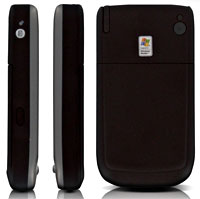 The front of the slim device is dominated by a 2.83″ 240×320 pixels transmissive TFT-LCD screen supporting 64k colours, with a row of four buttons and a joystick below.
The front of the slim device is dominated by a 2.83″ 240×320 pixels transmissive TFT-LCD screen supporting 64k colours, with a row of four buttons and a joystick below.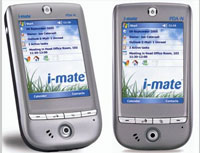 According to I-mate, the PDA-N notches up a rated battery life of 5 hours in GPS mode and 8 hours playing a looped video.
According to I-mate, the PDA-N notches up a rated battery life of 5 hours in GPS mode and 8 hours playing a looped video.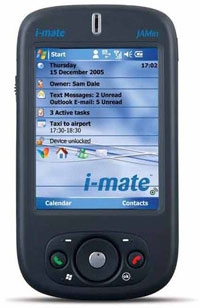 A week ahead of its scheduled launch, smartphone bigwigs i-mate have revealed details of their latest model, the JAMin.
A week ahead of its scheduled launch, smartphone bigwigs i-mate have revealed details of their latest model, the JAMin.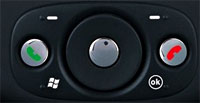 Switching from a 416 MHz Intel processor to a 200 MHz TI processor (we know it sounds like it must be slower but they’re not directly comparable), i-mate have stuck with the JAM form factor, adding a different button layout and twice the ROM.
Switching from a 416 MHz Intel processor to a 200 MHz TI processor (we know it sounds like it must be slower but they’re not directly comparable), i-mate have stuck with the JAM form factor, adding a different button layout and twice the ROM. Also known as the HTC Prophet (and O2 XDA Neo), the phone shouldn’t stir it up in the pocket department, measuring a compact 10.8 x 5.8 x 1.8cm and weighing 150g. Memory expansion is taken care of courtesy of a SD IO slot
Also known as the HTC Prophet (and O2 XDA Neo), the phone shouldn’t stir it up in the pocket department, measuring a compact 10.8 x 5.8 x 1.8cm and weighing 150g. Memory expansion is taken care of courtesy of a SD IO slot After many years of trotting around town with pockets stuffed full of a Palm PDA and a mobile phone, we decide that an all-in-one PDA/smartphone combo would be the best way to reduce our ostentatious trouser bulge.
After many years of trotting around town with pockets stuffed full of a Palm PDA and a mobile phone, we decide that an all-in-one PDA/smartphone combo would be the best way to reduce our ostentatious trouser bulge. The left hand side sports the camera button, volume control and voice memo switch, none of which are particularly well placed (it’s all too easy to fire off the voice memo/camera switched when turning the handset on).
The left hand side sports the camera button, volume control and voice memo switch, none of which are particularly well placed (it’s all too easy to fire off the voice memo/camera switched when turning the handset on).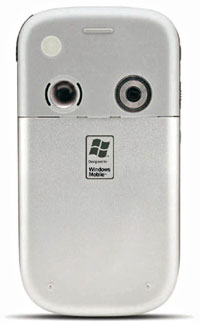 Performance
Performance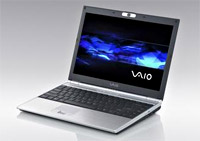 Sony has announced the Japanese release of two new laptops featuring the Intel Duo Core processor.
Sony has announced the Japanese release of two new laptops featuring the Intel Duo Core processor. The new super-skinny SZ series (0.9″ wide) comes with either a 945GM Express or the GeForce Go 7400 graphics card which offers an unusual SPEED/STAMINA switch.
The new super-skinny SZ series (0.9″ wide) comes with either a 945GM Express or the GeForce Go 7400 graphics card which offers an unusual SPEED/STAMINA switch.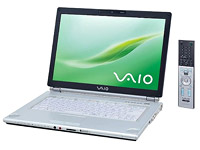 Sony F TV Series
Sony F TV Series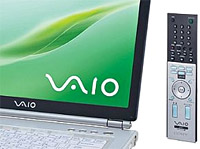 According to Sony Japan’s website, the laptops will be available in a range of configurations and made available in Japan over the next few weeks.
According to Sony Japan’s website, the laptops will be available in a range of configurations and made available in Japan over the next few weeks.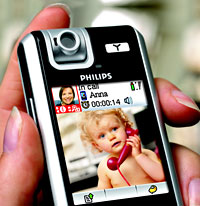 It’s been a long time coming, but Dutch enormo-corp Philips are looking set to finally roll out their innovative Wi-Fi-enabled VoIP telephone, the VP-5500.
It’s been a long time coming, but Dutch enormo-corp Philips are looking set to finally roll out their innovative Wi-Fi-enabled VoIP telephone, the VP-5500.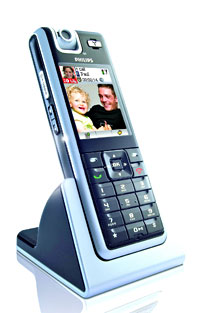 Announced way back in Sept 2005, the VoIP phone comes with a VGA camera that rotates up to 240 degrees, letting users check out their look on the built-in, high-resolution LCD display before committing a potential videocall fashion catastrophe.
Announced way back in Sept 2005, the VoIP phone comes with a VGA camera that rotates up to 240 degrees, letting users check out their look on the built-in, high-resolution LCD display before committing a potential videocall fashion catastrophe.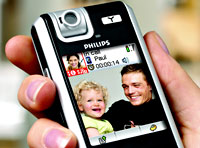 Built around established standards-based technologies like Wi-Fi and Linux, the VP5500 can be upgraded wirelessly, opening the door to future upgrades – giving operators the chance to add value-added services as the becmoe available.
Built around established standards-based technologies like Wi-Fi and Linux, the VP5500 can be upgraded wirelessly, opening the door to future upgrades – giving operators the chance to add value-added services as the becmoe available. To be honest, we’re still a little unsure about video calling.
To be honest, we’re still a little unsure about video calling.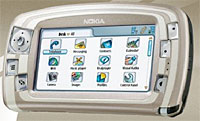 Two recent studies into mobile TV on 3G mobile phones have managed to produce rather inconclusive results concerning the willingness of the great British public to use the service and how much they’d be prepared to pay for it.
Two recent studies into mobile TV on 3G mobile phones have managed to produce rather inconclusive results concerning the willingness of the great British public to use the service and how much they’d be prepared to pay for it.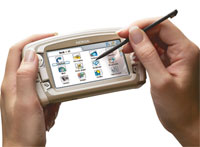 The feedback seemed back-slappingly reassuring, with 83 per cent of the triallists “satisfied” with the service, and 76 per cent indicating they’d be keen to take up the service within 12 months.
The feedback seemed back-slappingly reassuring, with 83 per cent of the triallists “satisfied” with the service, and 76 per cent indicating they’d be keen to take up the service within 12 months.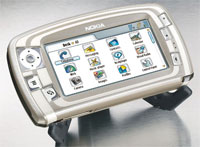 “This trial is further illustration that we are moving from a verbal only to a verbal and visual world in mobile communications,” said David Williams, O2’s technology chief.
“This trial is further illustration that we are moving from a verbal only to a verbal and visual world in mobile communications,” said David Williams, O2’s technology chief.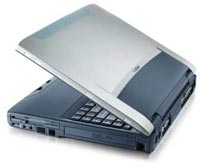 We’ve been asked by Toshiba to hold this story for a couple of days. The site that originally published it,
We’ve been asked by Toshiba to hold this story for a couple of days. The site that originally published it,  It might look like a run-of-the-mill Gameboy Advance SP, but the TAVI Portable Media Player packs a much mightier multimedia punch, with the wee fella letting you watch movies, playback music, look at your photos, listen to FM radio, read eBooks and record your own voice.
It might look like a run-of-the-mill Gameboy Advance SP, but the TAVI Portable Media Player packs a much mightier multimedia punch, with the wee fella letting you watch movies, playback music, look at your photos, listen to FM radio, read eBooks and record your own voice. Audio support is pretty generous too, with the unit offering MP3, WMA, OGG, AC3 and AAC playback.
Audio support is pretty generous too, with the unit offering MP3, WMA, OGG, AC3 and AAC playback.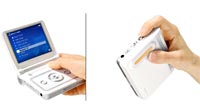 There’s also a built in FM radio and mic, line-in recording (audio only) and TXT reader support.
There’s also a built in FM radio and mic, line-in recording (audio only) and TXT reader support.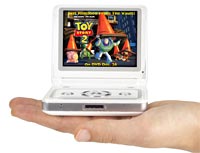 SPECIFICATIONS
SPECIFICATIONS PHOTOS & eBOOKS
PHOTOS & eBOOKS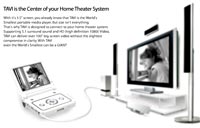 POWER
POWER Clearly suffering from an overdose on the hyperbole intake, Michael Dell has been getting all lyrical about Dell’s new ideas, unveiled at CES 2006.
Clearly suffering from an overdose on the hyperbole intake, Michael Dell has been getting all lyrical about Dell’s new ideas, unveiled at CES 2006.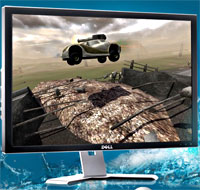 First up is the new Dell XPS 600 Renegade, a powerful, high-end gaming PC described as a (here we go again) ‘manifestation of power so pure it can only be described as supernatural.’
First up is the new Dell XPS 600 Renegade, a powerful, high-end gaming PC described as a (here we go again) ‘manifestation of power so pure it can only be described as supernatural.’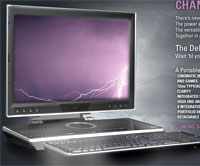 The attractive monitor offers WQXGA resolution (that’s 2560×1600 pixels to normal people), fast 11ms grey-to-grey response time, 700:1 contrast ratio and an integrated 9-in-2 memory card reader.
The attractive monitor offers WQXGA resolution (that’s 2560×1600 pixels to normal people), fast 11ms grey-to-grey response time, 700:1 contrast ratio and an integrated 9-in-2 memory card reader.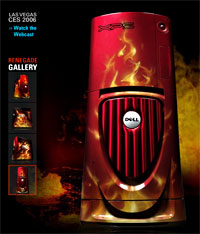 We’re not sure what a ‘portfolio’ design is, but this thing’s sure got it, along with ‘anodized articulating hinges’ and a detachable wireless keyboard and mouse.
We’re not sure what a ‘portfolio’ design is, but this thing’s sure got it, along with ‘anodized articulating hinges’ and a detachable wireless keyboard and mouse.